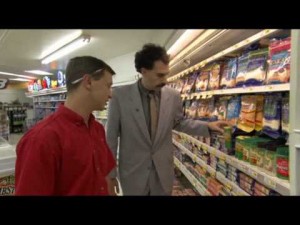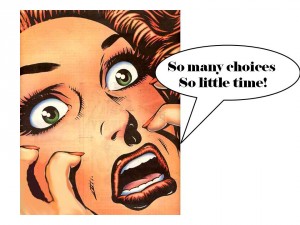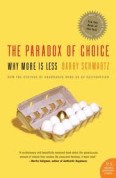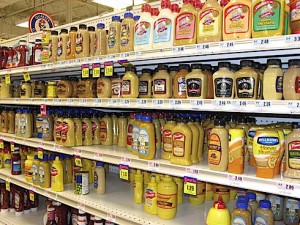 While my wife and I were visiting my father-in-law in Pittsburgh, we did some grocery shopping at the local Giant Eagle supermarket. I enjoy walking around the store, which is huge, checking out the almost unbelievable variety of products available in virtually every category of grocery. There is an entire aisle–50 to 60 feet of four-high shelves on both sides–devoted to nothing but cookies. Another aisle holds snack crackers and chips. You name it, they have an aisle for it; and every aisle is stocked with a dazzling array of choices for each and every product.
While my wife and I were visiting my father-in-law in Pittsburgh, we did some grocery shopping at the local Giant Eagle supermarket. I enjoy walking around the store, which is huge, checking out the almost unbelievable variety of products available in virtually every category of grocery. There is an entire aisle–50 to 60 feet of four-high shelves on both sides–devoted to nothing but cookies. Another aisle holds snack crackers and chips. You name it, they have an aisle for it; and every aisle is stocked with a dazzling array of choices for each and every product.
In the bread aisle, the rep from Thomas’ English Muffins was busy restocking the shelves with the 15 different varieties currently baked by Thomas’. Although I generally favor the Original, with all of the “Nooks and Crannies” which, when properly toasted to an almost-burnt crisp, hold delicious gobs of melted butter, this day I selected the Limited Edition Cranberry. Thomas’ also had a Limited Edition Pumpkin-Spice English Muffin available that day, but somehow, the thought of a pumpkin-flavored English Muffin didn’t work for me, though the Thomas’ rep told me that they are very popular and he has a hard time keeping the shelves stocked with Pumpkin-Spice.
 The experience got me to thinking about choices, and the wide array of choices we are presented with as consumers. I couldn’t help but be reminded of the scene in the 2006 movie “Borat: Cultural Learnings of America For Make Benefit Glorious Nation of Kazakhstan,” where Sacha Baron Cohen‘s Borat character is in an American grocery store examining the–to Borat–unbelievable number of different types of cheeses and packages of cheese for sale. [Here’s a link to the entire 4-minute cheese scene, which was reduced to about one-minute in the theatrical release of the movie.]
The experience got me to thinking about choices, and the wide array of choices we are presented with as consumers. I couldn’t help but be reminded of the scene in the 2006 movie “Borat: Cultural Learnings of America For Make Benefit Glorious Nation of Kazakhstan,” where Sacha Baron Cohen‘s Borat character is in an American grocery store examining the–to Borat–unbelievable number of different types of cheeses and packages of cheese for sale. [Here’s a link to the entire 4-minute cheese scene, which was reduced to about one-minute in the theatrical release of the movie.]
Giant Eagle is simply following the conventional wisdom among retailers, supported by scientific research, that consumers prefer large selections and are lured by more options and greater variety. But not every store believes that variety of product offerings is the surest path to success. Unlike most retailers, Trader Joe’s drastically restricts customers’ choices. They don’t carry household-name brands, and within any particular product category—pasta, for example—there are only a few options, [mostly house brands like Trader Giuseppe Pasta], compared to the myriad choices offered at the Safeway or Albertson’s down the street. As an aside, if you are interested in the behavioral economics explanation of TJ’s success–over 300 stores and growing, with the highest sales per square foot of any grocery chain in the US–check out this story, “Trader Joe’s, Where Less is More,” by Kay-Yut Chen and Marina Krakovsky, authors of the book, Secrets of the Moneylab: How Behavioral Economics Can Improve Your Business. Clearly though, when it comes to providing consumers with a plethora of choices, Trader Joe’s is an exception to the rule.
 Moving beyond the world of grocery shopping, into the larger domain of choices in general, we have to consider: why it is that sometimes, presented with a wide array of choices, rather than being exhilarated by the degree of choice-freedom provided, we can become paralyzed by the task of assessing options, and choose not to choose at all? It seems odd that choice aversion might ever happen in America, where, from the nation’s inception, autonomy, individuality, and self-determination have been foundational values; where, from the time of Washington and Jefferson to today with Bush and Obama, politicians and the voting public generally assume and act under the presumption that choice always provides social benefits. After all, don’t we strongly resist attempts to use public policy to restrict our personal choices? [Curiously, this doesn’t seem to stop interest groups of all persuasions from attempting to push their personal/ideological views as public policy that would constrain the behavioral choices of others with differing views, for example: Pro-Choice/Pro-Life, Gay Marriage/Sanctity of Marriage, ObamaCare/Free-Market Healthcare.]
Moving beyond the world of grocery shopping, into the larger domain of choices in general, we have to consider: why it is that sometimes, presented with a wide array of choices, rather than being exhilarated by the degree of choice-freedom provided, we can become paralyzed by the task of assessing options, and choose not to choose at all? It seems odd that choice aversion might ever happen in America, where, from the nation’s inception, autonomy, individuality, and self-determination have been foundational values; where, from the time of Washington and Jefferson to today with Bush and Obama, politicians and the voting public generally assume and act under the presumption that choice always provides social benefits. After all, don’t we strongly resist attempts to use public policy to restrict our personal choices? [Curiously, this doesn’t seem to stop interest groups of all persuasions from attempting to push their personal/ideological views as public policy that would constrain the behavioral choices of others with differing views, for example: Pro-Choice/Pro-Life, Gay Marriage/Sanctity of Marriage, ObamaCare/Free-Market Healthcare.]
There is, indeed, some evidence that a presumption that choice is always good may be incorrect, at least in the realm of public policy. “The Dark Side of Choice: When Change Impairs Social Welfare,” an article by Simona Botti and Sheena S. Iyengar published in 2006 in the Journal of Public Policy & Marketing, points out the sometimes detrimental effects of choice in the public policy realm. The authors ascribe three elements to the “dark side” of choice: information overload, a higher likelihood of dissatisfaction with the choice made, and a propensity to overpay for options that don’t have a commensurate increase in personal happiness.
Another recent study, conducted at Washington University in St. Louis, “Choosing Here and Now Versus There and Later,” corroborates the notion that when choosing among products, we [in our role as consumers] prefer having more options over having fewer options. But that’s not the case when we are making choices about the more distant future, such as when we are considering insurance, retirement plan options, or vacation plans six months in the future. The authors of the study, Joseph K. Goodman, PhD, and Selin A. Malkoc, PhD, both assistant professors of marketing at Olin Business School, suggest that psychological distance is what accounts for the difference in behavior. Psychological distance, both temporal and geographical, increases the similarity of the options in a category, making them appear more substitutable. When making decisions related to the future,the authors conclude that, “… consumers tend to focus on the end goal and less about how to get there and this leads to predictable changes in consumer behavior.”
 I found my own favorite take on the “too many choices” problem in the book, The Paradox of Choice – Why More Is Less, published in 2004 by American psychologist Barry Schwartz. Schwartz ranges far and wide in his study of choice behavior, but I was drawn to his views on the ideas of psychologist Herbert A. Simon from the 1950s, and how Schwartz relates Simon’s theories to the psychological stress that consumers face today when confronting seemingly unlimited choices. He notes some important distinctions between what Simon termed maximizers and satisficers.
I found my own favorite take on the “too many choices” problem in the book, The Paradox of Choice – Why More Is Less, published in 2004 by American psychologist Barry Schwartz. Schwartz ranges far and wide in his study of choice behavior, but I was drawn to his views on the ideas of psychologist Herbert A. Simon from the 1950s, and how Schwartz relates Simon’s theories to the psychological stress that consumers face today when confronting seemingly unlimited choices. He notes some important distinctions between what Simon termed maximizers and satisficers.
A maximizer is like a perfectionist when it comes to making a choice, someone who needs to be assured that their every purchase choice was the best that could be made. The only way a maximizer can know for sure that his choice is the perfect choice is to consider all the alternatives he can imagine. This can’t avoid being a psychologically difficult task, one that become even more daunting as the number of choices increases. The alternative to maximizing is to be a satisficer. A satisficer has criteria and standards, but, rather than searching for the perfect choice, satisficers are perfectly happy with an option that is “good enough.” A satisficer doesn’t worry about the possibility that there might be something better available, somewhere. Ultimately, Schwartz agrees with Simon’s conclusion, that satisficing–looking for good enough rather than demanding perfect–is, in fact, the maximizing strategy. Interestingly, it seems that a satisficer–willing to be happy with good enough–is much less likely to second-guess her own choices than the perfectionistic maximizer.
In this regard, I think about my own recent purchase of a new mobile phone. With so many brands to choose from, and so many model choices within each brand, each with a dizzying array of features, the choice-decision further complicated by carrier incentives and complex rate plans, I opted for simplicity. No change of carrier or mobile operating system for me; simply an upgrade to the best available Android phone [Samsung’s Galaxy SIII in case you were wondering]. No doubts. No second thoughts. I ‘m convinced I made a good enough choice.
 So, what do you do when you want some mustard, and the mustard shelf in your grocery store has 55 varieties of mustard? Probably best to act like a satisficer–set guidelines for price, style of mustard, type of container, acceptable brands to filter through the possibilities– and make a fairly quick and painless choice. Not so easy though, if you are looking for a movie to watch, a book to read, or a song to listen to. Millions of possibilities. Hard to even imagine what filters to apply. Personalized recommendations are particularly valuable in these situations. That’s why we love Netflix and Amazon and Pandora; they do the filtering for us and present us with a set of movies, books and songs that should satisfy our tastes.
So, what do you do when you want some mustard, and the mustard shelf in your grocery store has 55 varieties of mustard? Probably best to act like a satisficer–set guidelines for price, style of mustard, type of container, acceptable brands to filter through the possibilities– and make a fairly quick and painless choice. Not so easy though, if you are looking for a movie to watch, a book to read, or a song to listen to. Millions of possibilities. Hard to even imagine what filters to apply. Personalized recommendations are particularly valuable in these situations. That’s why we love Netflix and Amazon and Pandora; they do the filtering for us and present us with a set of movies, books and songs that should satisfy our tastes.
But even if the recommendation suits our tastes, there’s no guarantee that the choice will make us happy; that we’ll be flly satisfied by the choice. Perhaps, as Kevin Kelly suggested in his blog post “The Satisfaction Paradox,” ultimate choice–in the form of virtually unlimited options–may be ultimately unsatisfying.
But what about when you’re looking for a wife (some studies suggest that “good enough” choosers are happier) or a president?
The research cited in the post is focused on purchase decisions. Personally, I wouldn’t think of either the choice of a wife or the decision about who to vote for for president as a purchase decision.
Perhaps you could stretch the logic to infer that somehow or other a man or woman is trading some degree of freedom when he/she takes a wife/husband, but I think you are talking about the specific choice–which woman/man to marry?–rather than the broader question of whether or not to marry. When making that choice, all men and women are satisficers, since it is physically impossible to examine all of the women/men on earth in the quest for the perfect mate, and we make a “good enough” choice. We’ll tell ourselves that we’ve made a perfect choice and found the “one and only,” but it’s all in the name of increasing our satisfaction with the choice we’ve made. When things go awry it is often because new options [possible mates not considered when making the original “good enough” decision] show up on the scene and appear to be superior to the original choice, creating dissatisfaction. I know I am on dangerous ground here, because mate choices, except in the rarest of instances, are not logical and rational decisions, but are determined by emotions.
The choice of a president is a different matter altogether, and really outside the scope of the post and related research. When making that choice, it isn’t the plethora of options that turns out to be disappointing, it is the dearth–sometimes the complete absence–of a desirable choice.
Good post Dave. Another angle on this is the work of my business partner Jack Beauregard, who created a questionnaire and report called The Decision Making Style Report, based on his research at Harvard Divinity School. People have five key styles to making critical decisions: Analytical, Direct, Enthusiastic, Prepared and Relational. Each has positives and negatives. Most of us use one primary and sometimes a secondary. Once you understand how you make decisions, you can learn to reflect on whether you have created too many or not enough, how you feel about that, then CHOOSE. of course picking cheese might not be deemed a “critical” decision, but I think you get my point…
Paul,
I wonder if there is any relationship between the Decision Making Styles that Jack Beauregard identified and the satisficing [good enough is OK] versus maximizing [perfectionistic] approach when considering a vast array of options.
I also wonder if one of the reasons that business owners delay making a decision about succession or exit is because they are looking for a “perfect” rather than a “good enough” plan for their life after exiting the business.
Here’s another thought: Would the work of Succession Planners be easier if someone created a Recommendation Engine [like the Amazon book recommendations or Netflix movie recommendations]that could create personalized recommendations for a client’s “Life Plan After Retirement?”